First Painted Lady for the garden. Exactly three years to the day after moving in.
Tom also painted this great picture of a Long-tailed Tit for Michelle’s birthday card…
First Painted Lady for the garden. Exactly three years to the day after moving in.
Tom also painted this great picture of a Long-tailed Tit for Michelle’s birthday card…
Went on the “Orca Sea Safari” boat trip. Although good fun, nothing exceptional was seen at all. Four Little Egrets around Falmouth was about all we could muster.
The only wet and windy day of the holiday, so after dropping Michelle at St. Ives, we headed for the Land’s End Peninsula. After a walk in the drizzle and a play on Porthcurno beach, we settled down for a one hour sea-watch late afternoon:
After a strong W/SW wind, with heavy rain in the morning, the wind dropped and the rain cleared. 4:30-5:30…
Gannet x 100+ close inshore.
Manx Shearwater x 500+? Reasonably constant stream (every 3-4 minutes or so, sometimes with flocks of over 30). All birds west.
Rock Pipit
Razorbill
Oystercatcher x 3
Shag x c.10
Painted Lady – only one.
At St. Ives, in a 5-10 minute watch, it seemed that there were even more Shearwaters, again all heading west.
Whilst in the Rainforest “Biodome” at the Eden Project (Michelle had now joined us!) I heard a vaguely familiar call which I assumed to be a White-eye and assumed to be coming from some loud-speaker system designed to add to the mood. I was rather surprised to see that it was indeed a real bird which I later found to be Pale-bellied (Sulawesi) White-eye.
A rather confiding Chaffinch was also nearby.
In the evening we went to Prideaux Wood where we had reasonable views of Greater Horseshoe Bats.
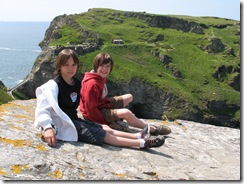 We spent a couple of hours visiting “King Arther’s” castle at Tintagel. The surrounding cliff faces held a small colony of nesting Fulmars (about twenty birds in total) and a pair of Rock Pipits and Ravens. On the sea, a single Gannet was seen as well as about thirty Guillemots. The beginning of the Painted Lady invasion was also seen with hundreds of butterflies here.
We spent a couple of hours visiting “King Arther’s” castle at Tintagel. The surrounding cliff faces held a small colony of nesting Fulmars (about twenty birds in total) and a pair of Rock Pipits and Ravens. On the sea, a single Gannet was seen as well as about thirty Guillemots. The beginning of the Painted Lady invasion was also seen with hundreds of butterflies here.
Many were also seen whilst surfing at nearby Mawgan Porth. Many more were seen over the following few days.
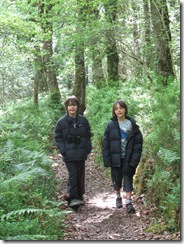 The beginning of a week’s holiday with the children in Pentewan, Cornwall. We stopped off overnight at Oakhampton and spent the morning in Dartmoor. We first went to Yarner Wood where we saw six Pied Flycatchers and a single Wood Warbler (though several more were heard.)
The beginning of a week’s holiday with the children in Pentewan, Cornwall. We stopped off overnight at Oakhampton and spent the morning in Dartmoor. We first went to Yarner Wood where we saw six Pied Flycatchers and a single Wood Warbler (though several more were heard.)
 We then went for a short drive through the moor, seeing Common Buzzards (many seen all week), several Stonechats, three Tree Pipits, two Peregrines, and four Ravens.
We then went for a short drive through the moor, seeing Common Buzzards (many seen all week), several Stonechats, three Tree Pipits, two Peregrines, and four Ravens.
A rather unusual cloud formation was also seen:
We eventually ended up at Haytor Rock which we climbed before having lunch at Widecombe-in-the-moor (where Tom saw a Spotted Flycatcher.)
Swifts are definitely attempting to breed above the bedroom. Had a lie in this morning and could hear the screaming birds coming in every ten minutes or so.
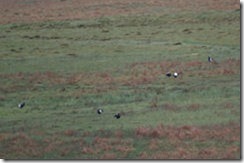 Myself and Tom were at Langdon Beck for first light in order to try to see the Black Grouse lek. We’d stayed overnight at Scotch Corner and were in place within the first hour of dawn. Unfortunately, so was thick fog!
Myself and Tom were at Langdon Beck for first light in order to try to see the Black Grouse lek. We’d stayed overnight at Scotch Corner and were in place within the first hour of dawn. Unfortunately, so was thick fog!
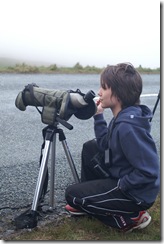 However, after driving up and down the road, we eventually stumbled upon a male and then shortly after, a female. Though the views were close, and it was a new bird for Tom, we had really come to see the lek, and fortunately, during a short break in the fog, I eventually found 16 males displaying. The views at first were poor, as although not too distant, the fog was still thick (the reason we had driven past the birds whilst scanning the road.) However the fog cleared and we watched the birds from the car for well over an hour. Also around were the usual upland breeding birds like Meadow Pipit, Curlew, Snipe, Lapwing, Redshank and so on, all in a very evocative setting.
However, after driving up and down the road, we eventually stumbled upon a male and then shortly after, a female. Though the views were close, and it was a new bird for Tom, we had really come to see the lek, and fortunately, during a short break in the fog, I eventually found 16 males displaying. The views at first were poor, as although not too distant, the fog was still thick (the reason we had driven past the birds whilst scanning the road.) However the fog cleared and we watched the birds from the car for well over an hour. Also around were the usual upland breeding birds like Meadow Pipit, Curlew, Snipe, Lapwing, Redshank and so on, all in a very evocative setting.
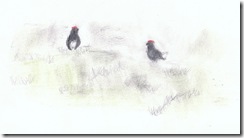
Black Grouse by Tom
Then our luck ran out! We then continued on to the second half of our day trip, to Seahouses where we were to catch the boat to the Farne Islands. Upon arrival and seeing the huge swell and crashing waves, it was obvious that no boats were to be sailing. We’d driven two hours further north to get there and were rather despondent. We sat and watched the sea for a while, noting Eider (about thirty, and the first ever good views for Tom), Ringed Plover, several Gannets, Turnstones, and Sandwich Terns, as well as a Whimbrel heading North,
As there had been much talk of an amazing east-coast fall predicted for the day, we decided to try and make the most of it by birding somewhere on the east coast and heading south whilst waiting for news from somewhere like Filey or Spurn. We therefore spent about an hour around Druidge and Creswell Bay, but it was virtually devoid of passerines, though we did manage to find a Wood Sandpiper and several Wall Browns were on the wing. We continued south, but the fall did not really materialise and so did not stop off anywhere else.
A Little Ringed Plover at Fowlmere tonight; quite a rarity for the site. Also a Hobby, a Whitethroat, and around forty Swifts.
Highlight on a windy night was undoubtedly a very elusive (but constantly singing) Garden Warbler, an overdue tick for Fowlmere. Three Sand Martins were also noted, as well as around ten Swifts and a flyover male Yellow Wagtail.
Not much was seen during an hour at Fowlmere apart from a House Martin and a Swift. The year's first Cuckoo at Fowlmere was also heard.
With no sign of yesterday’s Eastern Bonelli’s Warbler at Portland, we headed straight to the first summer Collared Flycatcher. After an hour of frustratingly brief glimpses through the crowd of people into the garden where it was staying, someone found the field where we were actually supposed to have been viewing from, and we immediately had great views. I was standing next to Adrian Webb at the time and he took this photo with his huge lens: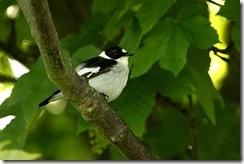
A Peregrine was the only other bird of note seen during the wait adding to the Hobby that we had seen somewhere in the New Forest. We then headed off for at sea-watch at the bill. The sea was rather quiet and in about an hour we managed the following:
Shag x 3
Guillemot - many.
Gannet - many.
Puffin x 3
Fulmar x 5
Kittiwake x 4
Manx Shearwater x 6
Turnstone x 3
Razorbill x 2
Rock Pipit x 11
Swallows- many in off.
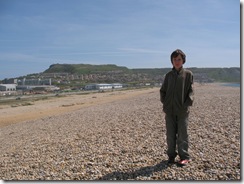 We then went for a walk around the bill and the obs’, finding not very much before heading off to double check the Bonelli’s site. Although there were many Phyllosc’s, they were all Chiffchaffs or Willow Warblers, so after a quick drink in the pub by the bill, decided to head home, arriving early evening.
We then went for a walk around the bill and the obs’, finding not very much before heading off to double check the Bonelli’s site. Although there were many Phyllosc’s, they were all Chiffchaffs or Willow Warblers, so after a quick drink in the pub by the bill, decided to head home, arriving early evening.
With Cris Freddi and Tom, I battled the Friday afternoon-bank-holiday weekend traffic and got to Dungeness with a couple of hours of light left. The bird hadn’t been seen for nearly an hour and we struggled with at best, possible sightings, most of which turned out to be Skylarks. Sifting through the numerous larks and Wheatears we were all rather down at the prospect of having to to continue our search the following morning and were very relieved at dusk to have half-decent flight views of what was obviously a Crested Lark. As all of us had seen Crested Lark many times abroad, we decided that despite the poor views we’d stick to our original plan and head towards Portland. So after a further half an hour wait until it was really too dark, we drove to a Travelodge at Southampton, arriving around midnight.